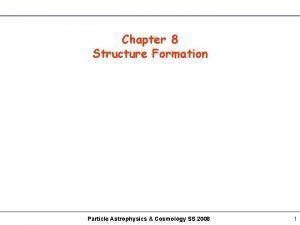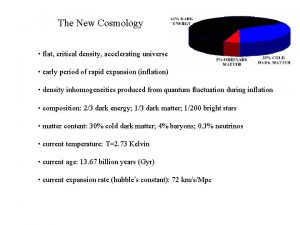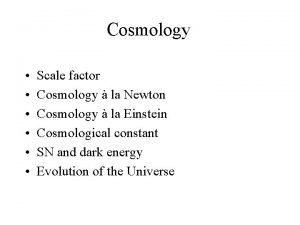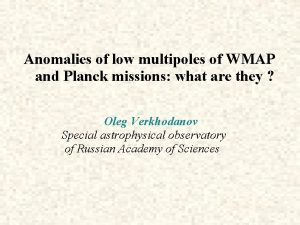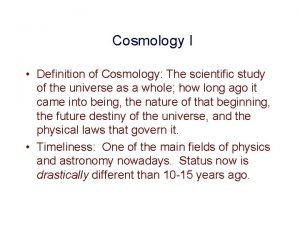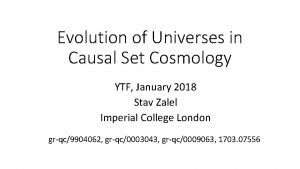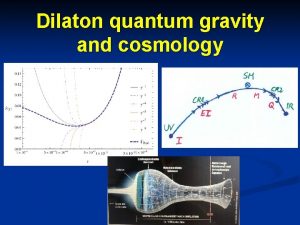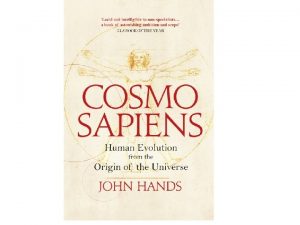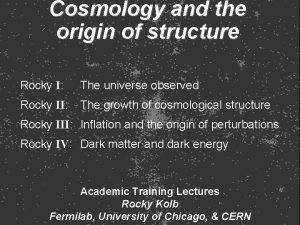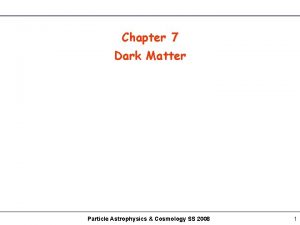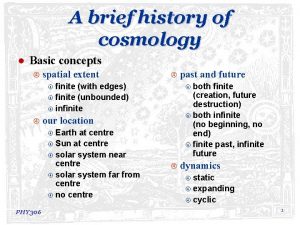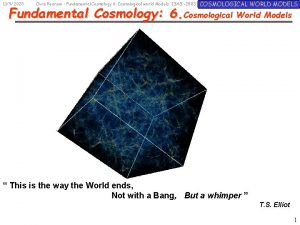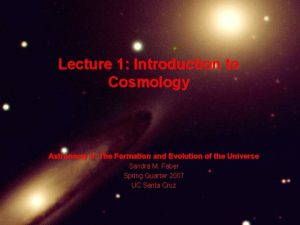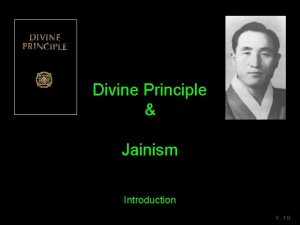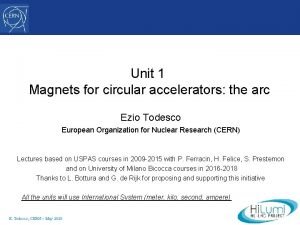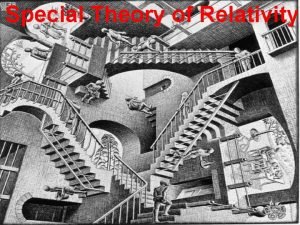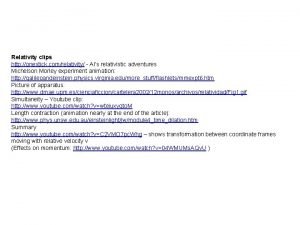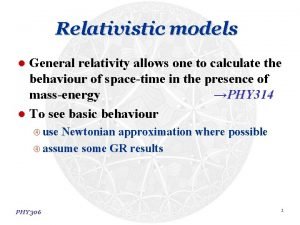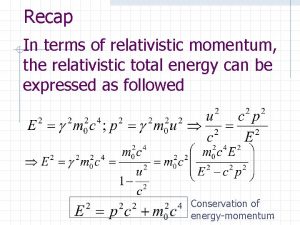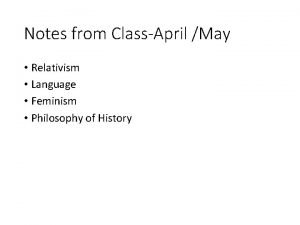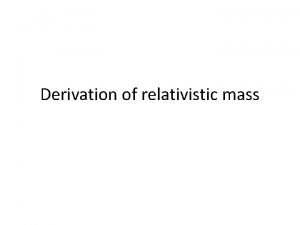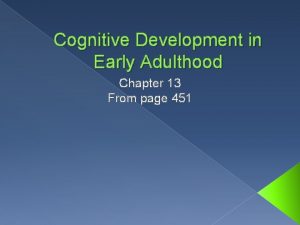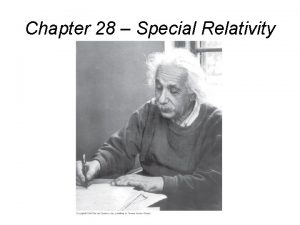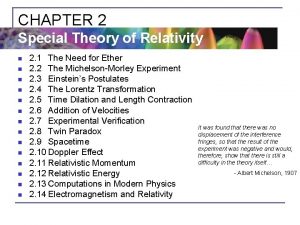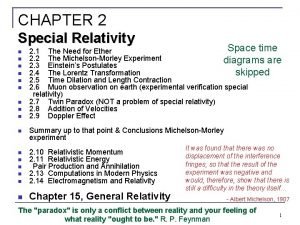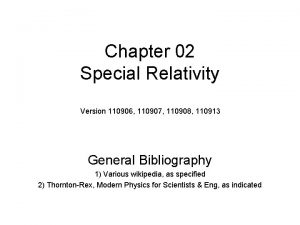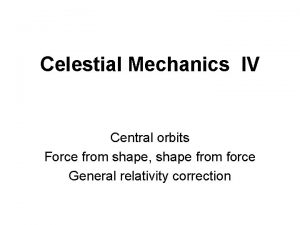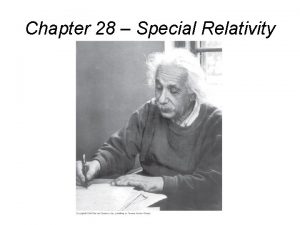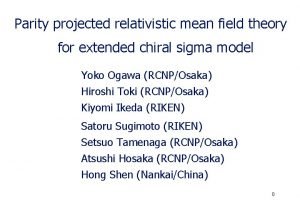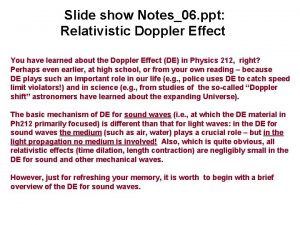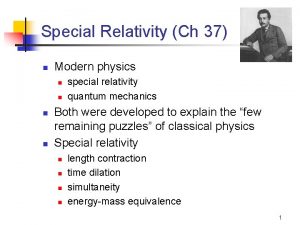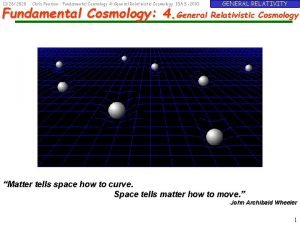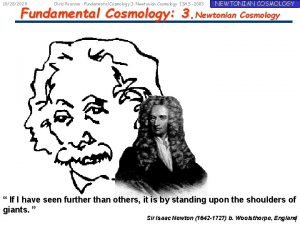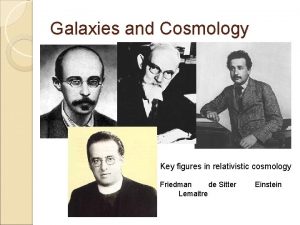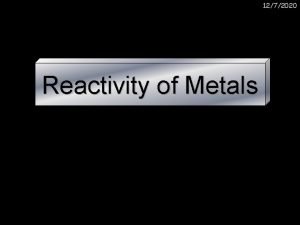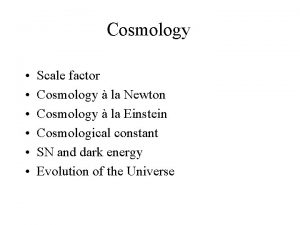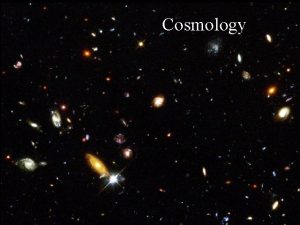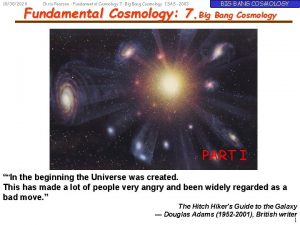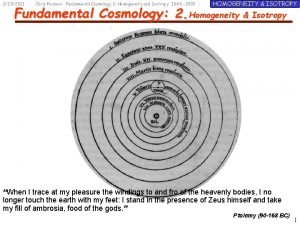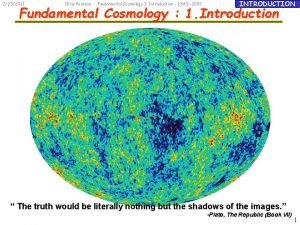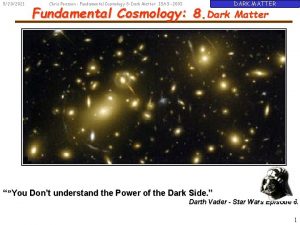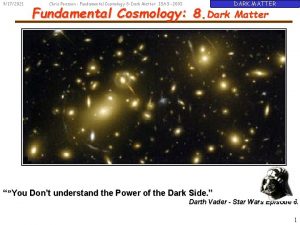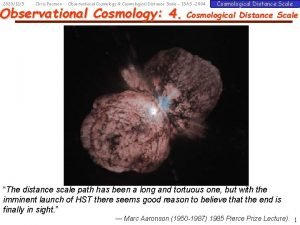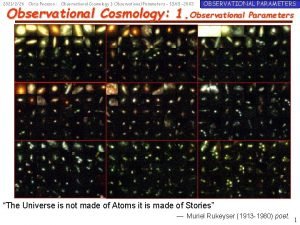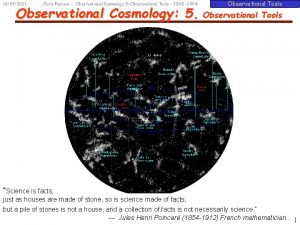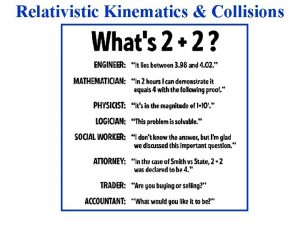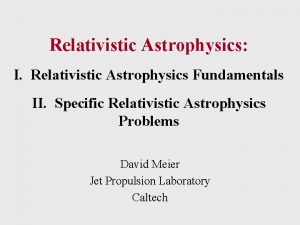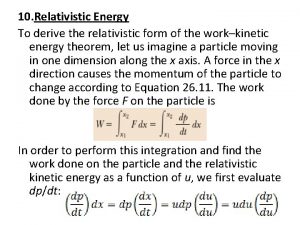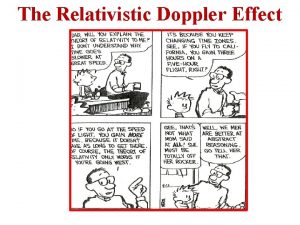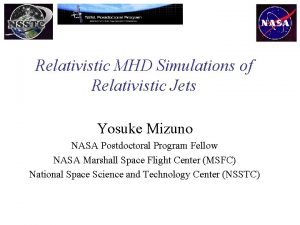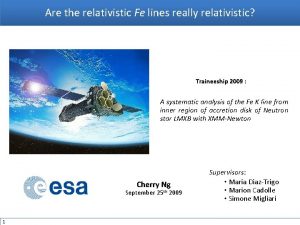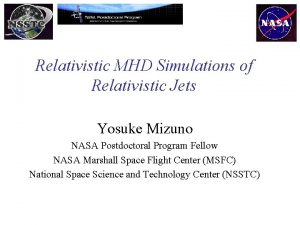1272020 Chris Pearson Fundamental Cosmology 4 General Relativistic
































- Slides: 32

12/7/2020 Chris Pearson : Fundamental Cosmology 4: General Relativistic Cosmology ISAS -2003 GENERAL RELATIVITY Fundamental Cosmology: 4. General Relativistic Cosmology “Matter tells space how to curve. Space tells matter how to move. ” John Archibald Wheeler 1

12/7/2020 Chris Pearson : Fundamental Cosmology 4: General Relativistic Cosmology ISAS -2003 GENERAL RELATIVITY 4. 1: Introduction to General Relativity 目的 • Introduce the Tools of General Relativity • Become familiar with the Tensor environment • Look at how we can represent curved space times • How is the geometry represented ? • How is the matter represented ? • Derive Einstein’s famous equation • Show we arrive at the Friedmann Equations via General Relativity • Examine the Geometry of the Universe • このセミナーの後で皆さんは私のことが大嫌いになるかな〜〜〜〜 Suggested Reading on General Relativity • Introduction to Cosmology - Narlikar 1993 • Cosmology - The origin and Evolution of Cosmic Structure. Coles & Lucchin 1995 • Principles of Modern Cosmology - Peebles 1993 2

12/7/2020 Chris Pearson : Fundamental Cosmology 4: General Relativistic Cosmology ISAS -2003 GENERAL RELATIVITY 4. 1: Introduction to General Relativity Newton v Einstein Newton: • Mass tells Gravity how to make a Force • Force tells mass how to accelerate Newton: • Flat Euclidean Space • Universal Frame of reference Einstein: • Mass tells space how to curve • Space tells mass how to move Einstein: • Space can be curved • Its all relative anyway!! 3

12/7/2020 Chris Pearson : Fundamental Cosmology 4: General Relativistic Cosmology ISAS -2003 GENERAL RELATIVITY 4. 1: Introduction to General Relativity The Principle of Equivalence Recall: Equivalence Principle A more general interpretation led Einstein to his theory of General Relativity PRINCIPLE OF EQUIVALENCE: An observer cannot distinguish between a local gravitational field an equivalent uniform acceleration Implications of Principle of Equivalence • Imagine 2 light beams in 2 boxes • the first box being accelerated upwards • the second in freefall in gravitational field • For a box under acceleration • Beam is bent downwards as box moves up • For box in freefall �photon path is bent down!! Fermat’s Principle: • Light travels the shortest distance between 2 points • Euclid = straight line • Under gravity - not straight line • �Space is not Euclidean ! 4

12/7/2020 GENERAL RELATIVITY Chris Pearson : Fundamental Cosmology 4: General Relativistic Cosmology ISAS -2003 4. 2: Geometry, Metrics & Tensors • The Interval (line element) in Euclidean Space: d. S z ds rsinqdf dr dy rsinq dx ds dz rdq q dr dq y f (dx 2+dy 2)1/2 2 -D r df x 3 -D 2 -D 3 -D d. S rdq dr 5

12/7/2020 Chris Pearson : Fundamental Cosmology 4: General Relativistic Cosmology ISAS -2003 GENERAL RELATIVITY 4. 2: Geometry, Metrics & Tensors • The Interval in Special Relativity (The Minkowski Metric) : • • The Laws of Physics are the same for all inertial Observers (frames of constant velocity) The speed of light, c, is a constant for all inertial Observers à Events are characterized by 4 co-ordinates (t, x, y, z) à Length Contraction, Time Dilation, Mass increase à Space and Time are linked P The notion of SPACE-TIME ds dt (dx 2+dy 2 +dz 2)1/2 6

12/7/2020 • Chris Pearson : Fundamental Cosmology 4: General Relativistic Cosmology ISAS -2003 4. 2: Geometry, Metrics & Tensors The Interval in Special Relativity (The Minkowski Metric) : Causally Connected Events in Minkowski Spacetime o Equation of a light ray, d. S 2=0, Trace out light cone from Observer in Minkowski S-T Spreading into the future Collapsing from the past t d. S 2 =0 d. S 2>0 d. S 2<0 o Area within light cone: d. S 2>0 Events that can affect observer in past, present, future. This is a timelike interval. Observer can be present at 2 events by selecting an appropriate speed. x d. S 2 =0 y GENERAL RELATIVITY d. S 2>0 o Area outside light cone: d. S 2<0 Events that are causally disconnected from observer. This is a spacelike interval. These events have no effect on observer. 7

12/7/2020 • Chris Pearson : Fundamental Cosmology 4: General Relativistic Cosmology ISAS -2003 GENERAL RELATIVITY 4. 2: Geometry, Metrics & Tensors The Interval in General Relativity : o In General The interval is given by: • gij is the metric tensor (Riemannian Tensor) : • Tells us how to calculate the distance between 2 points in any given spacetime • Components of gij • Multiplicative factors of differential displacements ( • Generalized Pythagorean Theorem dxi) 8

12/7/2020 • Chris Pearson : Fundamental Cosmology 4: General Relativistic Cosmology ISAS -2003 GENERAL RELATIVITY 4. 2: Geometry, Metrics & Tensors The Interval in General Relativity : Euclidean Metric 3 Dimensions Minkowski Metric 4 Dimensions 9

12/7/2020 • Chris Pearson : Fundamental Cosmology 4: General Relativistic Cosmology ISAS -2003 GENERAL RELATIVITY 4. 2: Geometry, Metrics & Tensors A little bit about Tensors - 1 o Consider a matrix M=(mij) o Tensor ~ arbitray number of indicies (rank) • Scalar = zeroth rank Tensor • Vector = 1 st rank Tensor • Matrix = 2 nd rank Tensor : matrix is a tensor of type (1, 1), i. e. mij o Tensors can be categorized depending on certain transformation rules: • Covariant Tensor: indices are low • Contravariant Tensor: indices are high • Tensor can be mixed rank (made from covariant and contravariant indices) • Euclidean 3 D space: Covariant = Contravariant = Cartesian Tensors • 注意 mijk 10

12/7/2020 • o Chris Pearson : Fundamental Cosmology 4: General Relativistic Cosmology ISAS -2003 GENERAL RELATIVITY 4. 2: Geometry, Metrics & Tensors A little bit about Tensors - 2 Covariant Tensor Transformation: Consider Scalar quantity f. Scalar �invariant under coordinate transformations Taking the gradient this normal has components Which should not change under coordinate transformation, so Also have the relation So for, Generalize for 2 nd rank Tensors, Covariant 2 nd rank tensors are animals that transform as : - etc…… 11

12/7/2020 • o Chris Pearson : Fundamental Cosmology 4: General Relativistic Cosmology ISAS -2003 GENERAL RELATIVITY 4. 2: Geometry, Metrics & Tensors A little bit about Tensors - 3 Contravariant Tensor Transformation: Consider a curve in space, parameterized by some value, r Coordinates of any point along the curve will be given by: Tangent to the curve at any point is given by: The tangent to a curve should not change under coordinate transformation, so Also have the relation So for, Generalize for 2 nd rank Tensors, Contravariant 2 nd rank tensors are animals that transform as : - etc…… 12

12/7/2020 • o Chris Pearson : Fundamental Cosmology 4: General Relativistic Cosmology ISAS -2003 GENERAL RELATIVITY 4. 2: Geometry, Metrics & Tensors More about Tensors - 4 Index Gymnastics o Raising and Lowering indices: Transform covariant to contravariant form by multiplication by metric tensor, gi, j o Einstein Summation: Repeated indices (in sub and superscript) are implicitly summed over Einstein c. 1916: "I have made a great discovery in mathematics; I have suppressed the summation sign every time that the summation must be made over an index which occurs twice. . . " Thus, the metric May be written as 13

12/7/2020 • o Chris Pearson : Fundamental Cosmology 4: General Relativistic Cosmology ISAS -2003 GENERAL RELATIVITY 4. 2: Geometry, Metrics & Tensors More about Tensors - 5 Tensor Manipulation o Tensor Contraction: Set unlike indices equal and sum according to the Einstein summation convention. Contraction reduces the tensor rank by 2. For a second-rank tensor this is equivalent to the Scalar Product Minkowski Spacetime (Special Relativity) spacelike timelike null 14

12/7/2020 • o Chris Pearson : Fundamental Cosmology 4: General Relativistic Cosmology ISAS -2003 GENERAL RELATIVITY 4. 2: Geometry, Metrics & Tensors More about Tensors - 6 Tensor Calculus o The Covariant Derivative of a Tensor: Derivatives of a Scalar transform as a vector How about derivative of a Tensor ? ? Does Lets see…. . Take our definition of Covariant Tensor transform as a Tensor? Problem Implies transformation coefficients vary with position Correction Factor: such that for , Redefine the covariant derivative of a tensor as; • Christoffel Symbols • Defines parallel vectors at neighbouring points • Parallelism Property: affine connection of S-T • Christoffel Symbols = fn(spacetime) , normal derivative ; covariant derivative 15

12/7/2020 • GENERAL RELATIVITY Chris Pearson : Fundamental Cosmology 4: General Relativistic Cosmology ISAS -2003 4. 2: Geometry, Metrics & Tensors Riemann Geometry Covariant Differentiation of Metric Tensor higher rank �extra Christoffel Symbol 1 General Relativity formulated in the non-Euclidean Riemann Geometry à Simplifications 1 à 40 linear equations - ONE Unique Solution for Christoffel symbol Shortest distance between 2 points is a straight line. SPECIAL RELATIVITY But lines are not straight (because of the metric tensor) GENERAL RELATIVITY Gravity is a property of Spacetime, which may be curved Path of a free particle is a geodesic where 16

12/7/2020 • Chris Pearson : Fundamental Cosmology 4: General Relativistic Cosmology ISAS -2003 GENERAL RELATIVITY 4. 2: Geometry, Metrics & Tensors The Riemann Tensor Recall correction factor for the transportation of components of parallel vectors between neighbouring points Such that we needed to define the Covariant derivative To transport a vector without the result being dependent on the path, Require a vector Ai(xk) such that - 1 1 Interchange differentiation w. r. t xn & xk and use Necessary condition for Can show: Ai, nk=Ai, kn 1 Where RHS=LHS=Tensor • Defines geometry of spacetime (=0 for flat spacetime). • Has 256 components but reduces to 20 due to symmetries. Rimkn is the Riemann Tensor 17

12/7/2020 • Chris Pearson : Fundamental Cosmology 4: General Relativistic Cosmology ISAS -2003 GENERAL RELATIVITY 4. 2: Geometry, Metrics & Tensors The Einstein Tensor • Lowering the second index of the Riemann Tensor, define • Contracting the Riemann Tensor gives the Ricci Tensor describing the curvature • Contracting the Ricci Tensor gives the Scalar Curvature (Ricci Scalar) Rimkn is the Riemann Tensor • Define the Einstein Tensor as Bianchi Identities • Symmetry properties of Multyplying by gimgkn and using above relations � or…… The Einstein Tensor has ZERO divergence 18

12/7/2020 • Chris Pearson : Fundamental Cosmology 4: General Relativistic Cosmology ISAS -2003 GENERAL RELATIVITY 4. 3: Einstein’s Theory of Gravity The Energy Momentum Tensor Density of mass /unit vol. Define Energy Momentum Tensor Density of jth component of momentum/unit vol. k-component of flux of j component of momentum The flux of the i momentum component across a surface of constant xk • Conservation of Energy and momentum - Tki; k=0 Dust approximation World lines almost parallel Speeds non-relativistic o Non relativistic particles (Dust) ro= ro(x) - Proper density of the flow ui= dxi/dt - 4 velocity of the flow § In comoving rest frame of N dust particles of number density, n Consider Units Density, r = mass/vol Momentum, p = energy/vol Looks like classical Kinetic energy In general, § In any general Lorentz frame 19

12/7/2020 • Chris Pearson : Fundamental Cosmology 4: General Relativistic Cosmology ISAS -2003 GENERAL RELATIVITY 4. 3: Einstein’s Theory of Gravity The Energy Momentum Tensor o Relativistic particles (inc. photons, neutrinos) Relativistic approximation Particles frequently colliding Pressure Speeds relativistic Particle 4 Momentum, e - energy density 1/3 since random directions o Perfect Fluid General Particle 4 Momentum, Fluid approximation Particles colliding - Pressure Speeds nonrelativistic In rest frame of particle Looks like gas law For any reference frame with fluid 4 velocity = u Pressure is important 20

12/7/2020 • Chris Pearson : Fundamental Cosmology 4: General Relativistic Cosmology ISAS -2003 GENERAL RELATIVITY 4. 3: Einstein’s Theory of Gravity The Einstein Equation After trial and error !! Einstein proposed his famous equation Einstein Tensor (Geometry of the Universe) Energy Momentum Tensor (matter in the Universe) ご結婚 • Classical limit • must reduce to Poisson’s eqn. for gravitational potential Basically: Relativistic Poisson Equation れ か つ お 21

12/7/2020 • Chris Pearson : Fundamental Cosmology 4: General Relativistic Cosmology ISAS -2003 GENERAL RELATIVITY 4. 3: Einstein’s Theory of Gravity The Einstein Equation “Matter tells space how to curve. Space tells matter how to move. ” Fabric of the Spacetime continuum and the energy of the matter within it are interwoven 注意 Does not give a static solution !! Einstein inserted the Cosmological Constant term L “The Biggest Mistake of My Life ” 22

12/7/2020 Chris Pearson : Fundamental Cosmology 4: General Relativistic Cosmology ISAS -2003 4. 3: Einstein’s Theory of Gravity • Solutions of the metric • Cosmological Principle: q q GENERAL RELATIVITY Isotropy �ga, b = da, b, only take Homogeneity �g 0, b = just spatial coords a=b terms g 0, a = 0 Jim Muth The Metric: Proper time interval: How about ? embed our curved, isotropic 3 D space in hypothetical 4 -space. à our 3 -space is a hypersurface defined by in 4 space. à length element becomes: Constrain dl to lie in 3 -Space (eliminate x 4) 23

12/7/2020 • Chris Pearson : Fundamental Cosmology 4: General Relativistic Cosmology ISAS -2003 GENERAL RELATIVITY 4. 3: Einstein’s Theory of Gravity Solutions of the metric Introduce spherical polar identities in 3 Space I. Multiply spatial part by arbitrary function of time R(t) : wont affect isotropy and homogeneity because only a f(t) II. Absorb elemental length into R(t) � r becomes dimensionless -2 III. Re-write a = k d. S The Robertson-Walker Metric • r, q, f are co-moving coordinates and don’t changed with time - They are SCALED by R(t) • t is the cosmological proper time or cosmic time - measured by observer who sees universe expanding around him • The co-ordinate, r, can be set such that k = -1, 0, +1 24

12/7/2020 GENERAL RELATIVITY 4. 3: Einstein’s Theory of Gravity The Robertson-Walker Metric and the Geometry of the Universe The Robertson-Walker Metric k ~ defines the curvature of space time k=0 : Flat Space k = -1 : Hyperbolic Space k = +1 : Spherical Space http: //map. gsfc. nasa. gov/ • Chris Pearson : Fundamental Cosmology 4: General Relativistic Cosmology ISAS -2003 25

12/7/2020 • Chris Pearson : Fundamental Cosmology 4: General Relativistic Cosmology ISAS -2003 GENERAL RELATIVITY 4. 3: Einstein’s Theory of Gravity The Robertson-Walker Metric and the Geometry of the Universe k=0 : Flat Space k = -1 : Hyperbolic Space k = +1 : Spherical Space 26

12/7/2020 • Chris Pearson : Fundamental Cosmology 4: General Relativistic Cosmology ISAS -2003 GENERAL RELATIVITY 4. 3: Einstein’s Theory of Gravity The Friedmann Equations in General Relativistic Cosmology Solve Einstein’s equation : Metric is given by R-W metric: Need: • metric gik • energy tensor Tik S Use so don’t confuse with Tensors Co-ordinates Non-zero gik Non-zero Gikl 27

12/7/2020 • Chris Pearson : Fundamental Cosmology 4: General Relativistic Cosmology ISAS -2003 GENERAL RELATIVITY 4. 3: Einstein’s Theory of Gravity The Friedmann Equations in General Relativistic Cosmology Non-zero components of Ricci Tensor Rik The Ricci Scalar R Non-zero components of Einstein Tensor Gik Sub �Einstein 28

12/7/2020 • Chris Pearson : Fundamental Cosmology 4: General Relativistic Cosmology ISAS -2003 GENERAL RELATIVITY 4. 3: Einstein’s Theory of Gravity The Friedmann Equations in General Relativistic Cosmology Non-zero components of Energy Tensor Tik 1 2 =-P =e 2 3 actually implied by Tki; k=0 Assume Dust: • P=0 • e = r c 2 1 3 2 29

12/7/2020 • GENERAL RELATIVITY Chris Pearson : Fundamental Cosmology 4: General Relativistic Cosmology ISAS -2003 4. 3: Einstein’s Theory of Gravity The Friedmann Equations in General Relativistic Cosmology 1 2 Return 3 S(t)=R(t) notation Finally ………… 2 3 Our old friends the Friedmann Equations 30

12/7/2020 • Chris Pearson : Fundamental Cosmology 4: General Relativistic Cosmology ISAS -2003 4. 4: Summary GENERAL RELATIVITY The Friedmann Equations in General Relativistic Cosmology • We have come along way today!!! Deriving the necessary components of The Einstein Field Equation • Spacetime and the Energy within it are symbiotic • The Einstein equation describes this relationship The Robertson-Walker Metric defines the geometry of the Universe The Friedmann Equations describe the evolution of the Universe THESE WILL BE OUR TOOLBOX FOR OUR COSMOLOGICAL STUDIES 31

12/7/2020 Chris Pearson : Fundamental Cosmology 4: General Relativistic Cosmology ISAS -2003 4. 4: Summary GENERAL RELATIVITY Fundamental Cosmology 4. General Relativistic Cosmology 終 Fundamental Cosmology 5. The Equation of state & the Evolution of the Universe 次: 32
 Cosmology
Cosmology Critical density
Critical density Scale factor cosmology
Scale factor cosmology Tomislav prokopec
Tomislav prokopec Definition of cosmology
Definition of cosmology Stav zalel
Stav zalel Crossover cosmology
Crossover cosmology Concordance model of cosmology
Concordance model of cosmology Cosmology
Cosmology Cosmology
Cosmology Newton cosmology
Newton cosmology Cosmology
Cosmology Intro to cosmology
Intro to cosmology Jain geography universe
Jain geography universe Relativistic circular motion
Relativistic circular motion Relativistic thinking example
Relativistic thinking example Relativistic mass formula
Relativistic mass formula Al's relativistic adventures
Al's relativistic adventures General relativity equation
General relativity equation Relativistic momentum
Relativistic momentum Relativistic thinking example
Relativistic thinking example Relativistic mass derivation
Relativistic mass derivation Early adulthood cognitive development
Early adulthood cognitive development Relativistic kinetic energy
Relativistic kinetic energy Relativistic kinetic energy
Relativistic kinetic energy Rest energy of a proton
Rest energy of a proton Relativistic kinetic energy
Relativistic kinetic energy Clairaut equation
Clairaut equation Relativistic kinetic energy
Relativistic kinetic energy Early adulthood cognitive development
Early adulthood cognitive development Relativistic mean field theory
Relativistic mean field theory Relativistic doppler effect ppt
Relativistic doppler effect ppt Relativistic momentum
Relativistic momentum
